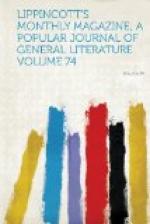Only the week before I had had the privilege of watching this identical old priest baptize the child of one of the most ancient nobles here, the ceremony being performed not in a church, but at the nobleman’s house. One godfather and one godmother are all that are required, the latter of whom holds the infant. On the godmother also a large share of duty devolves, there being certain gifts which she is bound by national custom to offer for acceptance on the occasion. Often, therefore, the duty of selecting a female sponsor becomes a somewhat invidious one. A handsome dress to the mother, no matter in what rank of life; a delicate lace cap to the main object of the occasion; a lace chemise for the same highly-honored small individual; and an elaborate silk pocket handkerchief to the officiating priest,—these, when of the best quality, and they are invariably so, mount up somewhat as regards price, seeing that everything is marvellously dear here in the matter of dress. The godfather, standing immediately in front of the large font brought specially for the purpose from the adjacent church, and at the right hand of his fellow-sponsor, simply presents a small golden cross, to be worn, it is supposed, ever afterward. Immediately behind the font, and facing the entire audience—for a large circle of friends had been invited to witness the ceremony—was placed the “holy picture” of the household, without which in Russia no homestead, whether belonging to rich or poor, is considered complete, and before which a lighted oil lamp ever stands burning—a “picture of God,” as the Russian children are taught from their earliest years to call it. Before this the priests bowed on entering.
The mode of baptism was immersion, after several exorcisms had been read and the priest had thrice blown in the infant’s face, signing him, also thrice, on the forehead and breast. Three tall lighted candles were affixed to the font, and others were held by the god-parents, except when they marched round the font in procession three times during “the chrism,” when the candles were laid down. The chrism consists in anointing the infant’s forehead, breast, shoulders and middle of the back with holy oil, after which comes the service, when the forehead, eyes, nostrils, mouth, ears, breast, hands and feet are again anointed, but this time with the holy unction prepared once a year, on Monday in Holy Week, within the walls of the Kremlin, and consecrated by the metropolitan in the cathedral of the Annunciation on Holy Thursday. Then comes the concluding act, when the priest cuts off a small portion of the child’s hair in four different places on the crown of the head, encloses it in a morsel of wax and throws it into the font, as a sort of first-fruits of that which has been consecrated.
S.E.




